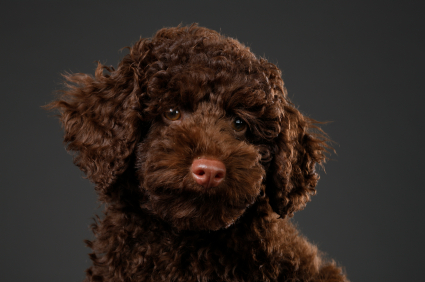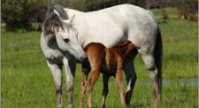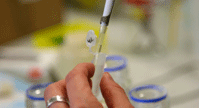B-Locus (Brown, Liver, Chocolate)
Description:
 TYRP1, or tyrosinase-related protein 1, is a protein that plays a role in the creation of the pigment eumelanin. This pigment is what causes the darkening of a dog’s coat color, creating black or brown coats. In the dominant form of the TYRP1 gene (aka the B Locus), enough eumelanin is produced so that the dog's coat appears black instead of chocolate. This dominant form appears when the dog has the “B” allele.
TYRP1, or tyrosinase-related protein 1, is a protein that plays a role in the creation of the pigment eumelanin. This pigment is what causes the darkening of a dog’s coat color, creating black or brown coats. In the dominant form of the TYRP1 gene (aka the B Locus), enough eumelanin is produced so that the dog's coat appears black instead of chocolate. This dominant form appears when the dog has the “B” allele.
A mutation in the TYRP1 gene can occur, causing a change in the production of the eumelanin. This dilutes the black color pigment into a brown color. This mutated gene is known as the "b" allele. When a dog is homozygous for the mutation, meaning he has two copies of the recessive allele (b/b), all black pigment appears brown. This color can also be referred to as liver or chocolate. In some breeds (such as the Australian Shepherd), this color is referred to as red. However, the B allele is dominant over the b allele. Therefore, a dog that is B/b or B/B will have a black coat, and not chocolate. The dog must have b/b in order to have a variation of the brown coloration.
The black (B) allele is dominant to the brown alleles (bs, bd, bc). If the dog is negative (n/n) for the dominant B allele, the dog will then be b/b and can display the colorations of bs, bd, or bc. These are three common mutations of the b/b allele. These will result in brown colors, instead of the black eumelanin production. It’s important to note that some breeds have additional mutations that can cause the chocolate coat color. These mutations have not been identified yet, however. For example, the exact cause for a different form of chocolate in French Bulldogs has not been determined, so there is no current way to test for this type chocolate.
Because TYRP1 is only associated with eumelanin, this mutation only has an effect on coat color of dogs that are E/E or E/e at the E locus. In order for a dog to have the opportunity to display colorations related to the B Locus, the dog must first have the dominant form of the E locus (E/E or E/e). Dogs that have the e/e allele only produce phaeomelanin in their coats. Phaeomelanin does not produce the darker coat colors. If a dog does not have E/e or E/E, a mutation at the B-locus will not have an effect on their coat color.
However, eumelanin is still produced in the foot pads and noses of dogs. These can appear yellow to red if recessive (e/e at MC1R), so the B locus still has an effect on these areas. Dogs that are e/e: b/b will have a brown nose and brown foot pads, rather than black. TYRP1 mutations can affect the nose and pad coloration, changing it from black to brown. Yellow lab puppies can have black or brown noses. However, the Vizsla breed will always have brown or flesh-colored noses.
B Locus Testing:
Animal Genetics currently offers a test for the B-Locus to determine how many copies of the recessive "b" allele a dog carries. Dogs can be DNA tested at ANY age.
Sample Type:
Animal Genetics accepts buccal swab, blood, and dewclaw samples for testing. Sample collection kits are available and can be ordered at Canine Test Now.
Testing Is Relevant For The Following Breeds:
Most breeds except some French Bulldogs and some Beagles.
Results:
Animal Genetics offers DNA testing for TYRP1 allele. The genetic test verifies the presence of the mutation and presents results as one of the following:
* Additional causes of this trait exist. A negative result for this mutation does not eliminate the possibility that an additional, yet unidentified mutation or mutations in the genome may lead to a similar trait.
B/b-Allele Results:
| B/B | Black | The dog carries two copies of the TYRP1 allele. In most cases the dog will express black pigment rather than chocolate, and will always pass on the "B" allele to any potential offspring. |
| B/b | Black | Both the dominant and recessive copies of the TYRP1 allele are present. In most cases the dog will express black pigment rather than brown, but carries the allele responsible for the brown phenotype. The dog can pass on either allele to potential offspring. |
| b/ b | Brown | Two copies of the recessive TYRP1 allele are present. In most cases the dog will express brown pigment rather than black as well as a brown nose and foot pads. The dog will always pass on the recessive allele to all potential offspring. |
Submit a Sample for Testing:
To submit a sample for testing please go to Canine Test Now.
To order a sample collection kit please go to Order Sample Collection kits.
Cost per sample is $40.00. Please see our Canine Fee Schedule for all test rates.










